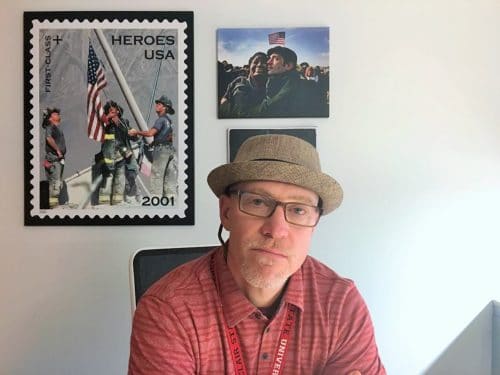
Professor Thomas E. Franklin was honored for the 15th anniversary of 9/11, for capturing the iconic photo, “Raising the Flag at Ground Zero.”
Photo by Victoria Campisi
On the 15th anniversary of Sept. 11, 2001, Professor Thomas E. Franklin discussed the ongoing impact of his photo, which became one of the most well-known pictures taken of the horrific event.
Prior to becoming a professor at Montclair State University’s School of Communication and Media, Franklin worked as a photojournalist for the The Record for 23 years. It was while he was working at The Record that he captured the famous photo, “Raising the Flag at Ground Zero.”
“I was actually in the office early that morning,” he said, “and an editor had come running into the photo department saying that a plane had crashed into the World Trade Center.” He recalled being able to see the towers out of the fourth floor newsroom in Hackensack, New Jersey, and knowing right away “that it wasn’t an accident.”
“My photo editor just said, ‘Go,’ and I went down and attempted to get into the city,” he said. After taking pictures from afar for most of the morning, it was not until early afternoon that Franklin made his way onto a boat from Jersey City to Ground Zero.
The famous shot was taken at 5:01 p.m. The photo, earning a finalist place for a Pulitzer Prize for Breaking News Photography in 2002, consists of three firemen raising the American flag as they are surrounded by the devastation.
“I had taken pictures all day, and I was aware of how important my role as a photojournalist was that day to document history,” he said.
“I didn’t immediately recognize that it was more important than anything else I had shot that day,” he said. “I did recognize the symbolism in what they were doing, but those were just passing moments.”
“The firemen raised the flag. It wasn’t a performance. I shot it from a distance, and it was over just like that.”
After it was shared with the Associated Press, the unique image was seen in many publications around the world and started to gain momentum.
Featured by the U.S Postal Service, the photo was turned into a postage stamp, raising over 10 million dollars from proceeds to help victims of 9/11.
The popularity of the photo is a very bittersweet idea for Franklin.
“It’s bitter in the sense that I wish 9/11 never happened and our country didn’t have to endure that senseless murder of thousands of innocent people and how our country and our lives have changed since then,” he said. “Sweet in the sense that it raised money and, even now 15 years later, I still hear from people and how much the picture means to them.”
“It is very humbling,” Franklin said, “but it also speaks to the power of what a photograph can do.”
The 15th anniversary was particularly busy for Franklin. The flag in the photo, which was missing for several years, was found and placed in the 9/11 museum in Lower Manhattan.
Franklin was featured in a documentary which aired on The History Channel this past Sunday on 9/11, along with a few other interviews of the same type which aired this week.
Franklin has covered the ceremony at Ground Zero multiple times over the past 15 years. Thinking back to the cold and windy day one year after the horrific event, he remembered the immensely somber event to be “the saddest thing [he’s] ever seen.”
“The ceremony and the anniversary of 9/11 is something I really don’t look forward to,” he said. “There’s a certain sense of dread I feel every time this time of year comes around, but it’s really important that we remember, and important that we pay our respects.”
Franklin encourages up-and-coming photojournalists to pursue their passion, work really hard at what they do and “follow their heart.”
“I believe my photograph is a good example of the power of a photograph, not only to communicate but to reach people and to speak to people on a level that maybe words and video can’t,” he said.
Thinking back to top moments in his career, Franklin said, “What I remember the most are the people I’ve met and the stories I’ve gotten to tell and the connections I’ve made and, in some instances, trying to create a broader understanding for people.”
When asked how his life has changed because of this photo, Franklin said, “It hasn’t changed my life, but Sept. 11 changed my life. It changed all our lives.”
“You can never forget that it is a photograph taken after thousands of innocent people were murdered, and lives were forever destroyed. The ripple effects of those tragic events are still felt today,” he said. “The loss in so many people’s lives can never be made up. It’s immeasurable.”


